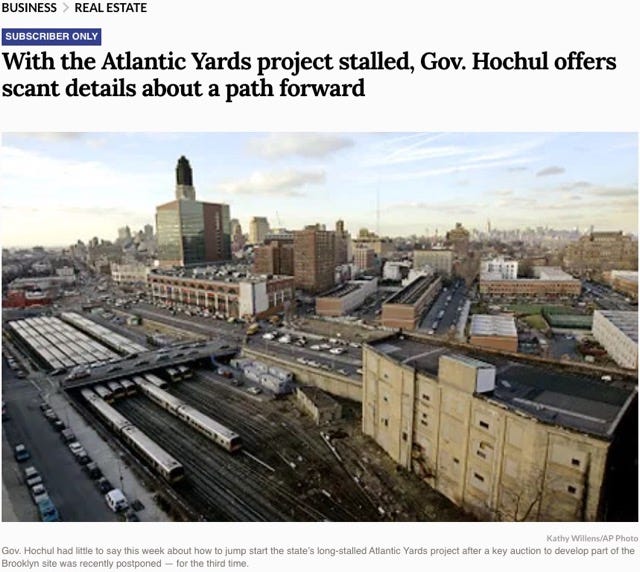Weekly Digest: Rising AMI Means Higher 'Affordable' Rents
NYC officials add a caveat: allowable rents may not be realistic.
This digest (#22) offers a way for people to keep up with my Atlantic Yards/Pacific Park Report blog, as well as my other coverage in this newsletter and elsewhere.
As I’ve written, including in my recent overview article for Urban Omnibus, Watch This Space, an under-appreciated factor in the project’s saga is the cost of delay.
Delay leads, typically, to rising construction costs and strains on financing. It also leads, inexorably, to rising Area Median Income (AMI), the metric for calculating income-targeted “affordable” housing.
An astounding chart
So I try to keep track of the annual calculations for AMI and the associated rents. In 2024, as I wrote, the “affordable” apartments—meaning rents targeted to 30% of income—have gotten ever more expensive.
With “low-income” defined as up to 80% of AMI, that means—as shown in the chart below—that a studio could rent for $2,174, a one-bedroom for $2,330, and two-bedroom for $2,796, and a three-bedroom for $3,230.
Is that realistic for all income categories? Not sure.
Does it defy common understanding of low-income? Of course
Is it realistic for middle-income categories? No way. That’s likely why the New York City Department of Housing Preservation and Development (HPD) added a new caveat, highlighted in the screenshot above, alerting readers that the maximum rents listed may not be realistic.
In some cases, specific rent amounts are shaped by various subsidy programs. In others, as with the recent 130% units at Atlantic Yards/Pacific Park buildings, the rents sought were lower than could be requested, because, well, the developers know that the market wouldn’t support them.
From: Substack
May 14: What Affordable Housing Graphics Conceal--or Reveal. A New York State chart on Atlantic Yards affordability only tracks categories; a new graphic shows the rising costs.
As produced for my recent Urban Omnibus article (my working title: “Whatever Happened to Atlantic Yards?”), Ben Keel’s graphic shows the costs of delay. Note that the chart only looks at two-bedroom units, but it’s still broadly representative of income ranges and relative costs.

It shows that, while the first three buildings with affordable units contained a range of income “bands," the most recent four buildings are limited to apartments at 130% of Area Median Income, or AMI.
That’s enabled by the now-expired 421-a tax break, which has come in for significant criticism.
From: Atlantic Yards/Pacific Park Report
May 13: Daily News gets a vague quote from Gov. Hochul re Atlantic Yards, cites "myriad complications," which is kind of a euphemism.
The article used a photo of the Metropolitan Transportation Authority’s Vanderbilt Yard before the western third of the three-block railyard was subsumed into (half of) the arena block, with the railyard function moved two blocks east.
Moreover, the building in the photo has long since been demolished. It's "Atlantic Yards down the memory hole" or a lack of institutional memory.
May 15: Real estate lawyer admits that allowing "affordable" units at 130% of Area Median Income was "a mistake." Last four Atlantic Yards towers had only 130% AMI.
May 16: As "affordable" rents rise with 2024 Area Median Income, a "low-income" 1-BR could cost $2,330! Now HPD warns that maximum rents may not be realistic.
May 17: In 2022, the developer claimed, dubiously, the (now-lapsed) Quality of Life meetings fostered accountability. Where can the Pacific Park Conservancy be queried? After all, there are Quality of Life complaints about the dog run.
May 18: So, those 130% Area Median Income (AMI) income-linked "affordable" units won't stay regulated forever, maybe just 35 years. But no one will be evicted at the 35-year mark.





